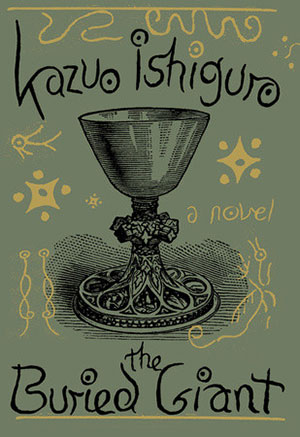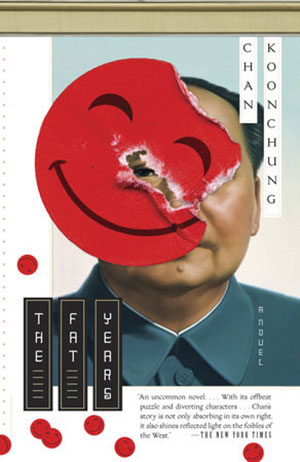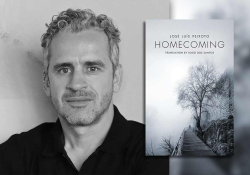Forgetting the Past: Nineteen Thoughts on Kazuo Ishiguro’s The Buried Giant and Chan Koonchung’s The Fat Years

1. Kazuo Ishiguro’s long-awaited The Buried Giant (2015), his first novel in ten years, is set in a mythologized fifth-century Britain in which pixies, dragons, and ogres live alongside humans. On the first page of the novel, we are told that “ogres were not so bad provided one did not provoke them.” And Sir Gawain, who once served under King Arthur, is one of the memorable cast of characters.
2. A versatile and Booker Prize–winning author, Ishiguro has previously experimented with and mastered different genres—e.g., detective fiction in When We Were Orphans (2000) and speculative fiction in Never Let Me Go (2005). Perhaps surprisingly, then, his exploration of the fantasy genre sparked some controversy, especially since he seemed to dismiss the classification, asking in an interview with the New York Times, “Will [readers] understand what I’m trying to do, or will they be prejudiced against the surface elements? Are they going to say this is fantasy?”
 3. Fantasy or not, at the heart of The Buried Giant is a love story, even though the main characters, Axl and his wife Beatrice, are not your typical lovers in fiction. Instead, they are an elderly couple who have spent their entire life together and now lead a simple existence on the outskirts of a village where they are rather ill-treated and are forbidden by the town’s council to have candles in their chamber due to their old age. Night after night, they sit in the engulfing dark. If, as they say, light symbolizes knowledge and knowledge is power, Axl and Beatrice are helplessly deprived of both.
3. Fantasy or not, at the heart of The Buried Giant is a love story, even though the main characters, Axl and his wife Beatrice, are not your typical lovers in fiction. Instead, they are an elderly couple who have spent their entire life together and now lead a simple existence on the outskirts of a village where they are rather ill-treated and are forbidden by the town’s council to have candles in their chamber due to their old age. Night after night, they sit in the engulfing dark. If, as they say, light symbolizes knowledge and knowledge is power, Axl and Beatrice are helplessly deprived of both.
4. But sitting in utter darkness deep into the night is not the only problem that Axl and Beatrice have to endure and get used to. There is also a mysterious, infectious, and ubiquitous mist of forgetfulness that affects everyone in the community. Not only do the villagers rarely talk about the distant past because no one remembers it clearly, they also have trouble remembering more recent events. Even conversations exchanged not long ago are difficult to recall, if not completely eradicated. Beatrice comments exasperatedly, “It’s queer the way the world’s forgetting people and things from only yesterday and the day before that. Like a sickness come over us all.” Forgetting is normal and remembering is a daunting, exhausting task.
5. During a conversation, Beatrice is introduced to one possible theory to explain this strange affliction and terrifying collective amnesia—a theory that, in itself, is no less terrifying: that perhaps God himself has become forgetful and neglectful and no longer cares to remember mortal man’s “events far distant, events of the same day.” Indeed, if a memory eludes even the almighty, how then can that memory be said to exist?
6. Axl and Beatrice do remember that they have a grown-up son who no longer lives with them in their village, although their memory of him is hazy and incomplete. Axl admits he does not even recall his face at all, while Beatrice believes it’s a strong and handsome face. Only fragments of the young man survive in the elderly couple’s memory, and these unsubstantial remembrances surely are not enough to piece together a whole story, a whole history. What drove their son away? Did they quarrel? Was it because of something that Axl and Beatrice said or did? They do not remember, regardless of how hard they try. This failure in remembering pains them greatly, constantly.
In this universe created by Ishiguro, forgetting is normal and remembering is a daunting, exhausting task. Apart from death, forgetting is perhaps one of the biggest enemies for lovers.
7. And so they decide to take action. They are determined to undertake a journey to their son’s village. They also hope the journey will help them retrieve other treasured memories. In this universe created by Ishiguro, then, going on a quest is not only the privilege of the young. Perhaps, to younger people, memories are less precious because they have time to create more. For Axl and Beatrice, however, they need to remember, for there is not much time left for them given their advanced age. Part of the success of The Buried Giant is its ability to make readers empathize with the weary couple’s urgency to locate their son and lost memories.
8. The Buried Giant is a heartwarming and heartbreaking love story in equal measures. When asked whether some things should remain hidden from the mind and forever unremembered, especially memories that are disturbing and upsetting, Beatrice responds with such confidence that one cannot help but hope that the best will turn out for the couple: “Axl and I wish to have again the happy moments we shared together. . . . We’ll have the bad ones come back too, even if they make us weep or shake with anger. For isn’t it the life we shared?”
 9. How is Kazuo Ishiguro’s A Buried Giant, a story set in a distant British past, related to Chan Koonchung’s The Fat Years,[1] a novel depicting a dystopian contemporary China? In both, people are plagued with collective amnesia and live in oblivion.
9. How is Kazuo Ishiguro’s A Buried Giant, a story set in a distant British past, related to Chan Koonchung’s The Fat Years,[1] a novel depicting a dystopian contemporary China? In both, people are plagued with collective amnesia and live in oblivion.
10. In The Fat Years, an entire month (or to be precise, twenty-eight days) in early 2011 is “missing,” erased.[2] This period coincides with the chaotic gap between the collapse of the world economy and the official start of China’s Golden Age of Ascendancy. To most people, these two important historical events took place simultaneously. They do not remember the missing month and therefore do not think to look for it or restore it. The month has disappeared in officially doctored books and media evidence as well as the public’s consciousness.
11. People also tend to forget important events in recent Chinese history or remember them in a far more positive light, even inaccurately, such as the 1989 Tiananmen Square massacre, the April Fifth Movement, the Cultural Revolution, the Great Leap Forward, the Campaign to Suppress Counter-revolutionaries, and the KMT-CCP civil war. As in George Orwell’s 1984, history has been rewritten and books that are not in accordance with the Communist Party’s historical discourse are banned. Fang Caodi, one of the characters in the novel who is also one of the few people who possesses unclouded memories of these traumatic past events, laments: “Certain collective memories seemed to have been completely swallowed up by a cosmic black hole, never to be heard of again.” Only two types of people exist in China: those who forget and the much smaller number who remember.
Only two types of people exist in China: those who forget and the much smaller number who remember. This collective amnesia is compounded with a collective euphoria.
12. This collective amnesia is compounded with a collective euphoria. People seem to be perpetually happy, buoyant, very gratified, as if they are entirely content to be born Chinese, living in the greatest nation of the world, at this particular moment in time. Ignorance is bliss in “The Age of Satisfaction”: “Everybody looks like those happy revolutionary workers or soldiers and peasants in those Cultural Revolution posters.” In other words, most people are devoid of individuality and, possibly, of independent thought. They are like zombies on Ecstasy. Even journalists and intellectuals, who in the past had the conscience to criticize certain policies and practices of the government, appear satisfied with how China is being run by the Communist Party, which is now perceived to be “great, glorious, always correct.”
13. True, in the world portrayed in Chan’s The Fat Years, “China is now the only locomotive powering global economic growth.” Everywhere else in the world people suffer from economic crisis. But what is behind the citizenship’s collective and eerie happiness? One high-ranking party official, in the epilogue of the novel, explains that the government has added small doses of Ecstasy to the drinking water to induce a mild euphoria in everyone in the country. The tampering of water here is reminiscent of the paranoid conspiracies that arose in the United States in the 1950s that putting fluoride in water was a Communist plot to spread socialist ideas. Ironically, in the case of The Fat Years, adding chemicals in the water is indeed a Communist plot to weaken the Chinese people’s skepticism about the government’s policies and activities. In the novel, the populace has unknowingly drunk the government’s Kool-Aid.
14. The drugged water makes people happy. Does it also make one forgetful? Is that why so many Chinese people have forgotten what happened in the recent past?
15. Is God really responsible for the lingering mist of forgetfulness in The Buried Giant?
16. In The Buried Giant, the mist in fact comes from the dragon Querig, whose breath has been put under a spell cast by Merlin and now fills the land and obscures people’s memories. Shrouded in the she-dragon’s breath, people innocently forget things both new and old. As a result, everyone, even former enemies—the Britons and the Saxons—live harmoniously. And peace, as long as Querig draws breath, is maintained.
17. This gets interesting when The Buried Giant and The Fat Years are read together. The dragon, according to Helmut Nickel, is “the most widely known image of Chinese iconography.”[3] Indeed, the dragon is almost synonymous with China in the collective cultural imagination. Although Ishiguro’s and Chan’s novels are very different in a number of respects—e.g., geographical and temporal setting, genre, language, and narrative structure—there seems to be a kind of long-distance dialogue between the two.
18. While in The Buried Giant, which belongs to the fantasy genre, the use of a magic spell put on a she-dragon can account for people’s amnesia, The Fat Years must offer a more believable explanation. How does one whole month disappear from people’s memories? Why do Chinese citizens no longer remember, or at least accurately remember, events that happened in the recent past? In the epilogue of the book, one chilling theory is put forward: they had brainwashed themselves.
19. In Kazuo Ishiguro’s The Buried Giant, collective amnesia can be interpreted as a test for Axl and Beatrice’s true love. Apart from death, forgetting is perhaps one of the biggest enemies for lovers. As one character asks, “How will you and your husband prove your love for each other when you can’t remember the past you’ve shared?” Despite the mist of forgetfulness, relentless and omnipresent, the elderly couple hold on to fragments of their past and are determined to restore more of their lost treasured memories. Theirs is a love story that triumphs over memory loss, old age, and dragon’s breath. Theirs is a story of hope, even though the ending of the book is left ambiguous. Chan Koonchung’s The Fat Years paints a darker, more cynical world in which people might willingly choose amnesia so they can focus on making and spending money. “Everybody was living very well and very few people had any interest in recalling the Cultural Revolution and June 1989, so those memories just naturally fade away.” They have buried the giant of history to live in the fat years of the present.
Hong Kong
[1] The Fat Years was first published in Chinese in 2009 and translated into English by Michael S. Duke in 2011.
[2] The “fat years” of the title refer to the very prosperous two years between the missing month and 2013, the year in which the novel begins.
[3] Helmut Nickel, “The Dragon and the Pearl,” Metropolitan Museum Journal 26 (1991), 139–46.















